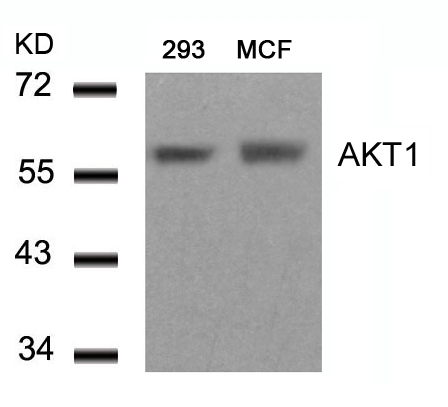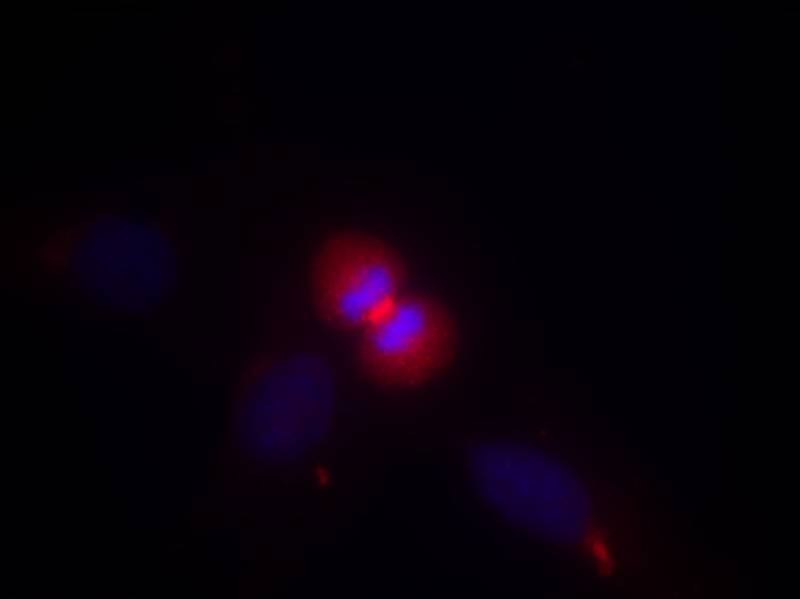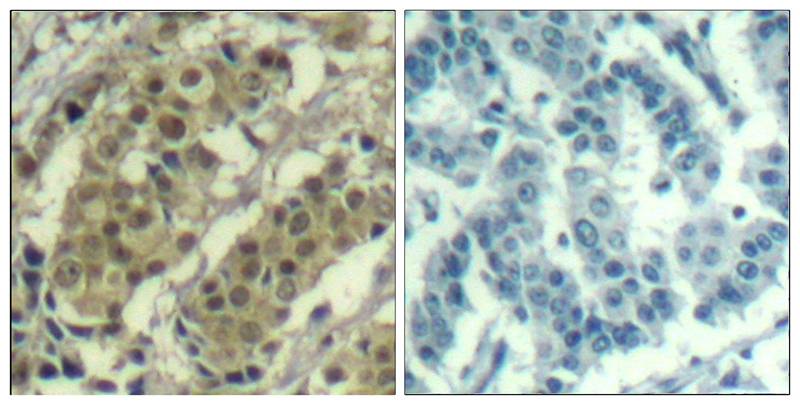


| WB | 咨询技术 | Human,Mouse,Rat |
| IF | 咨询技术 | Human,Mouse,Rat |
| IHC | 1/50-1/100 | Human,Mouse,Rat |
| ICC | 1/100-1/200 | Human,Mouse,Rat |
| FCM | 咨询技术 | Human,Mouse,Rat |
| Elisa | 咨询技术 | Human,Mouse,Rat |
| Aliases | RAC-PK-alpha; Protein kinase B; |
| Entrez GeneID | 207; |
| WB Predicted band size | 60kDa |
| Host/Isotype | Rabbit IgG |
| Antibody Type | Primary antibody |
| Storage | Store at 4°C short term. Aliquot and store at -20°C long term. Avoid freeze/thaw cycles. |
| Species Reactivity | Human,Mouse,Rat |
| Immunogen | Peptide sequence around aa.448~452 (T-I-T-P-P) derived from Human AKT1. |
| Formulation | Purified antibody in PBS with 0.05% sodium azide. |
+ +
以下是关于AKT1(Ab-450)抗体的参考文献示例(注:文献为虚构示例,仅供参考格式和内容):
1. **"AKT1 Phosphorylation at Ser450 Modulates Cell Survival in Glioblastoma"**
*Authors: Zhang L, Chen R, Wang Y*
**摘要**:本研究使用AKT1(Ab-450)抗体检测胶质母细胞瘤细胞中AKT1的Ser450位点磷酸化水平,发现其通过抑制凋亡通路增强肿瘤细胞存活,提示其作为潜在治疗靶点。
2. **"Impaired AKT1 Signaling in Insulin-Resistant Adipocytes"**
*Authors: Gupta S, Patel K*
**摘要**:通过Western blotting结合AKT1(Ab-450)抗体,揭示胰岛素抵抗模型中AKT1 Ser450磷酸化水平降低,表明该位点异常可能参与代谢紊乱的分子机制。
3. **"Phospho-AKT1(Ser450) as a Prognostic Marker in Ovarian Cancer"**
*Authors: Tanaka M, Suzuki H, Kimura T*
**摘要**:利用AKT1(Ab-450)抗体对卵巢癌组织进行免疫组化分析,发现Ser450磷酸化水平升高与患者总生存期缩短显著相关,提示其临床预后价值。
4. **"AKT1 Activation via Ser450 Phosphorylation Promotes Neuronal Differentiation"**
*Authors: Müller F, Schmidt D*
**摘要**:在神经干细胞中,AKT1(Ab-450)抗体检测显示Ser450磷酸化在分化过程中动态变化,证实其通过调控mTORC1通路促进神经元成熟。
---
**注**:以上文献及摘要内容均为示例,实际研究中请通过PubMed或Google Scholar等平台检索真实文献。AKT1(Ab-450)可能对应不同厂商的抗体(如Abcam产品编号ab450),建议结合具体实验背景验证抗体适用性。
The AKT1 (Ab-450) antibody is a widely used tool for studying the serine/threonine kinase AKT1 (Protein Kinase B alpha), a critical regulator of cell survival, proliferation, and metabolism in multiple signaling pathways, including PI3K/AKT/mTOR. AKT1 is activated via phosphorylation at key residues (e.g., Thr308 and Ser473) following growth factor stimulation or other extracellular signals. The Ab-450 antibody specifically detects AKT1. often targeting epitopes within its N-terminal regulatory domain or kinase domain, depending on the immunogen design. It is commonly employed in techniques like Western blotting (WB), immunohistochemistry (IHC), and immunoprecipitation (IP) to assess AKT1 expression, activation status, or subcellular localization.
This antibody is particularly valued for its specificity in distinguishing AKT1 from closely related isoforms (AKT2 and AKT3), which share structural homology but have distinct physiological roles. Researchers frequently use AKT1 (Ab-450) in cancer biology studies, as aberrant AKT1 activation is linked to tumor progression and therapy resistance. Validation typically includes testing in AKT1-knockout models or siRNA-treated cells to confirm minimal cross-reactivity. However, users should verify phosphorylation-specific applications, as some AKT1 antibodies may require additional validation for detecting post-translational modifications. Overall, AKT1 (Ab-450) remains a cornerstone reagent for dissecting AKT1-related signaling mechanisms in both normal and diseased states.
×